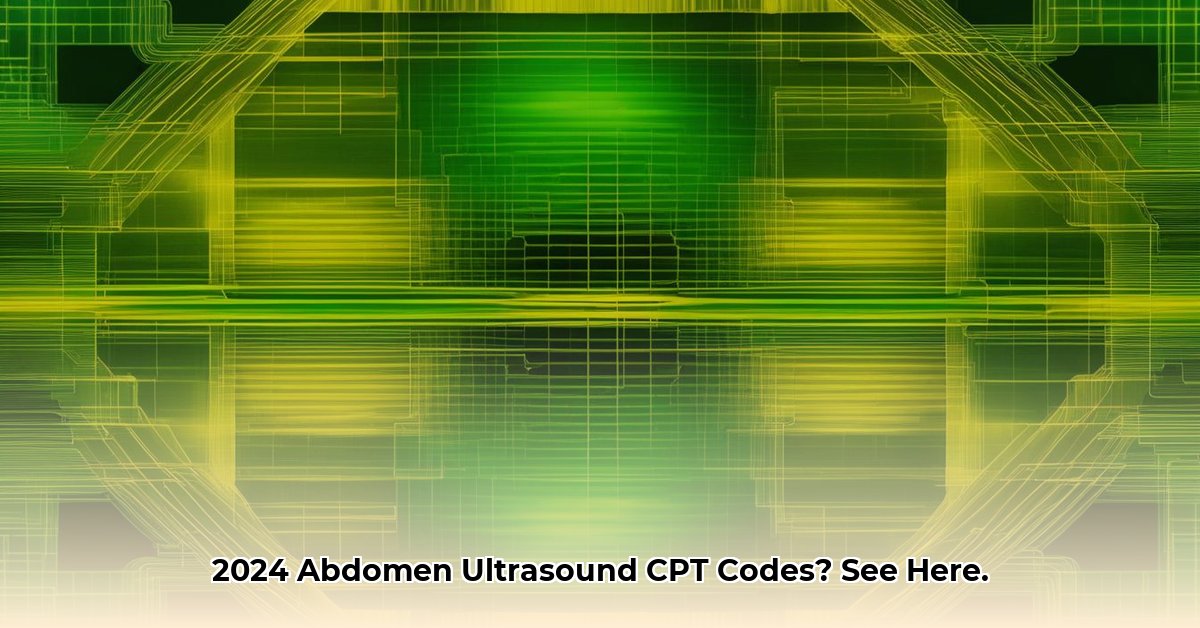Selecting the Correct Abdominal Ultrasound CPT Code
Accurate billing for abdominal ultrasounds hinges on selecting the correct Current Procedural Terminology (CPT®) code. This guide provides a comprehensive overview of common abdominal ultrasound CPT codes for 2024, offering practical guidance for accurate billing. Remember to consult the most current AMA CPT® codebook for definitive code descriptions and guidance.
Complete vs. Limited Abdominal Ultrasounds
-
76700 – Complete Abdominal Ultrasound: Select this code when performing a comprehensive examination of the abdomen, including the liver, gallbladder, pancreas, kidneys, spleen, and major abdominal vessels. This code typically includes a general view of the retroperitoneal space.
-
76705 – Limited Abdominal Ultrasound: Use this code for a focused examination of a specific organ, quadrant, or area within the abdomen when a complete abdominal ultrasound is not medically necessary. This is appropriate for follow-up examinations or when evaluating a specific clinical concern.
Retroperitoneal Ultrasounds
-
76770 – Complete Retroperitoneal Ultrasound: Choose this code for a dedicated and thorough examination of the retroperitoneal structures, including the kidneys, adrenal glands, aorta, and inferior vena cava.
-
76775 – Limited Retroperitoneal Ultrasound: Use this code when focusing on a specific organ or area within the retroperitoneum.
Ultrasound for Transplanted Kidney
- 76776 – Ultrasound, Transplanted Kidney, with Duplex Doppler: This code is specific to the examination of a transplanted kidney and inherently includes a duplex Doppler assessment of blood flow.
Duplex Doppler Ultrasounds
While often an integral part of abdominal ultrasound examinations, duplex Doppler assessment for abdominal vessels typically does not have a separate CPT® code. Duplex Doppler findings should be documented within the report of the primary procedure code used (e.g., 76700, 76705, 76770, 76775, or 76776). However, for duplex scans of the abdominal aorta and inferior vena cava, consider these codes:
- 93978 – Complete Duplex Scan of Abdominal Aorta and IVC: Use for a full assessment of blood flow in both vessels.
- 93979 – Limited Duplex Scan of Abdominal Aorta and IVC: Use when evaluating a specific segment of either vessel.
Ultrasound Guidance and Follow-up
-
76942 – Ultrasound Guidance for Needle Placement: This code is used when ultrasound is utilized for guidance during procedures such as biopsies or drain placements.
-
76970 – Ultrasound Study Follow-up or Limited Repeat: Select this code for subsequent ultrasound examinations performed to monitor a patient’s condition or re-evaluate a specific area.
Modifiers, Documentation, and Billing Best Practices for Abdominal Ultrasounds
Using Modifiers
Modifiers provide additional information about the services provided. Common modifiers for ultrasound include:
- 26 – Professional Component: Use this modifier when billing for the physician’s interpretation of the ultrasound images.
- TC – Technical Component: Use this modifier when billing for the performance of the ultrasound scan itself.
- 50 – Bilateral Procedure: Indicates the procedure was performed on both sides of the body.
- 59 – Distinct Procedural Service: Use to distinguish between separate and distinct procedures performed on the same day.
- 76 – Repeat Procedure by Same Physician: Use when the same physician repeats the procedure.
- 77 – Repeat Procedure by Different Physician: Use when a different physician repeats the procedure.
Other modifiers may be applicable depending on the specific circumstances. Always refer to the most current CPT® codebook and payer guidelines for appropriate modifier usage.
Essential Documentation
Thorough documentation is crucial for supporting your billing and ensuring proper reimbursement. Include the following in your ultrasound documentation:
- Medical Necessity: Clearly document the reason for the ultrasound, linking it to the patient’s signs, symptoms, or diagnosis.
- Organs Examined: Specify the exact organs or areas examined, avoiding generic terms like “abdomen.”
- Technique Used: Describe the specific ultrasound techniques employed.
- Findings: Detail your observations, including measurements, characteristics of abnormalities, and any other relevant information.
- Interpretation: Provide a clear and concise interpretation of the findings, including a diagnosis or assessment.
Avoiding Claim Denials
Common reasons for claim denials include incorrect coding, insufficient documentation, and lack of demonstrated medical necessity. Meticulous attention to detail and adherence to payer guidelines can help minimize denials.
2024 Updates and Future Trends
While many CPT® codes remain consistent, staying informed about annual updates and emerging trends is essential. Refer to the AMA CPT® codebook and CMS guidelines for the latest information. Some areas to watch include:
- Artificial Intelligence (AI) in Ultrasound: AI is playing an increasing role in image analysis and interpretation. This may lead to new codes or revisions to existing ones.
- Contrast-Enhanced Ultrasound (CEUS): The use of contrast agents in ultrasound is becoming more prevalent, potentially impacting coding practices.
- Evolving Documentation Requirements: Payers may refine documentation requirements to reflect advancements in technology and clinical practice.
By staying informed and adapting to changes in the field, you can ensure accurate billing and optimal reimbursement for your abdominal ultrasound services.
Disclaimer: CPT® is a registered trademark of the American Medical Association. This information is for educational purposes only and is not a substitute for professional medical or legal advice. Always consult the most current AMA CPT® codebook and relevant payer guidelines for precise coding and billing information.
- Bento Box Trays Streamline Restaurant Meal Presentation and Transport - December 13, 2025
- Plastic Bento Boxes Face Scrutiny Over Sustainability Impacts - December 11, 2025
- Bento Tray Revolutionizes Organized Meal Transport and Presentation - December 10, 2025










